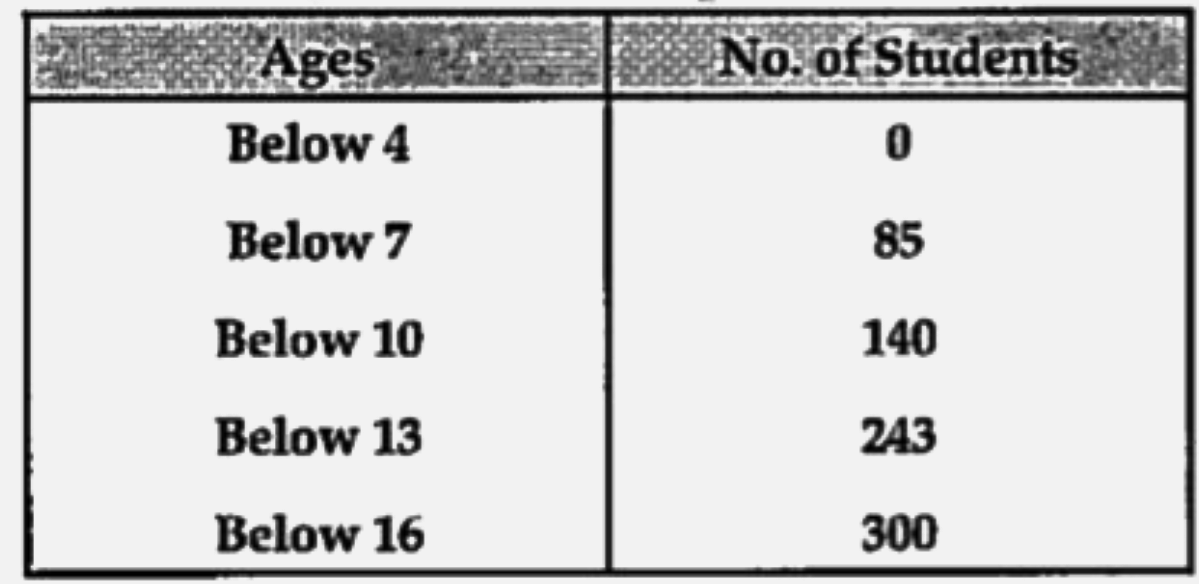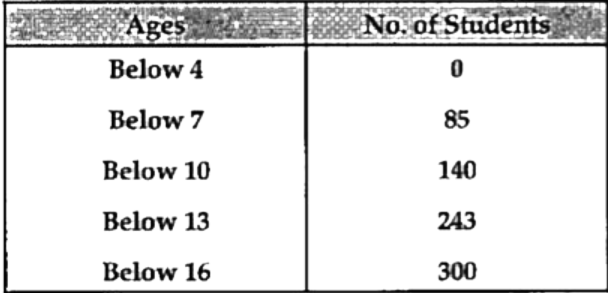Construct the frequency distribution table from the following cumulative frequency table:
AgesNo of studentsBelow40Below785Below10140Below13243Below16300
State the age group which has the least number of students
The correct Answer is:7−10
To construct the frequency distribution table from the given cumulative frequency table, we will follow these steps:
Step 1: Identify the Class Intervals
The cumulative frequency table provides us with the upper limits of the age groups. We will derive the class intervals based on these limits.
- Below 4: 0 students (no interval)
- Below 7: 85 students (4 to 7)
- Below 10: 140 students (7 to 10)
- Below 13: 243 students (10 to 13)
- Below 16: 300 students (13 to 16)
Step 2: Calculate the Frequencies
To find the frequency for each class interval, we will subtract the cumulative frequency of the previous interval from the cumulative frequency of the current interval.
1. For the interval 4 to 7:
- Frequency = Cumulative frequency (below 7) - Cumulative frequency (below 4)
- Frequency = 85 - 0 = 85
2. For the interval 7 to 10:
- Frequency = Cumulative frequency (below 10) - Cumulative frequency (below 7)
- Frequency = 140 - 85 = 55
3. For the interval 10 to 13:
- Frequency = Cumulative frequency (below 13) - Cumulative frequency (below 10)
- Frequency = 243 - 140 = 103
4. For the interval 13 to 16:
- Frequency = Cumulative frequency (below 16) - Cumulative frequency (below 13)
- Frequency = 300 - 243 = 57
Step 3: Construct the Frequency Distribution Table
Now we can summarize the class intervals and their corresponding frequencies in a table format:
| Age Group | No of Students |
|-----------|----------------|
| 4 - 7 | 85 |
| 7 - 10 | 55 |
| 10 - 13 | 103 |
| 13 - 16 | 57 |
Step 4: Identify the Age Group with the Least Number of Students
From the frequency distribution table, we can see that the age group with the least number of students is 7 - 10, with a frequency of 55.
Final Answer
The age group which has the least number of students is 7 to 10.
---
The cumulative frequency table provides us with the upper limits of the age groups. We will derive the class intervals based on these limits.
- Below 7: 85 students (4 to 7)
- Below 10: 140 students (7 to 10)
- Below 13: 243 students (10 to 13)
- Below 16: 300 students (13 to 16)
To find the frequency for each class interval, we will subtract the cumulative frequency of the previous interval from the cumulative frequency of the current interval.
- Frequency = Cumulative frequency (below 7) - Cumulative frequency (below 4)
- Frequency = 85 - 0 = 85
- Frequency = Cumulative frequency (below 10) - Cumulative frequency (below 7)
- Frequency = 140 - 85 = 55
- Frequency = Cumulative frequency (below 13) - Cumulative frequency (below 10)
- Frequency = 243 - 140 = 103
- Frequency = Cumulative frequency (below 16) - Cumulative frequency (below 13)
- Frequency = 300 - 243 = 57
Now we can summarize the class intervals and their corresponding frequencies in a table format:
|-----------|----------------|
| 4 - 7 | 85 |
| 7 - 10 | 55 |
| 10 - 13 | 103 |
| 13 - 16 | 57 |
From the frequency distribution table, we can see that the age group with the least number of students is 7 - 10, with a frequency of 55.
The age group which has the least number of students is 7 to 10.
Topper's Solved these Questions
- BOOK - ICSECHAPTER - STATISTICSEXERCISE - EXERCISE 18 (B)6videos
STATISTICS
- BOOK - ICSECHAPTER - STATISTICSEXERCISE - EXERCISE 18 (B)6videos
STATISTICS
- BOOK - ICSECHAPTER - SOLUTION OF RIGHT TRIANGLESEXERCISE - EXERCISE 2435videos
SOLUTION OF RIGHT TRIANGLES
- BOOK - ICSECHAPTER - STATISTICS AND GRAPH WORK EXERCISE - TOPIC - 2 (4 Marks Questions)14videos
STATISTICS AND GRAPH WORK
Similar Questions
Construct the frequency distribution table from the following cumulative frequency table:
AgesNo of StudentsBelow40Below785Below10140Below13243Below16300
State the number of students in the age group 10-13View SolutionConstruct the frequency distribution table from the following cumulative frequency table :

State the number of students in the age group 10 - 13.View SolutionConstruct the frequency distribution table from the following cumulative frequency table :

State the age - group which has the least number of students .View SolutionConstruct a frequency distribution table from the following cumulative frequency distribution :
Calss IntervalFrequency5−101810−153015−204620−257325−3090View SolutionConstruct a frequency distribution table from the following cumulative frequency distribution :
Calss IntervalCumulative Frequency10−19820−291930−392340−4930View SolutionConstruct a cumulative frequency distribution table from the following frequency table :
C.IFrequency 11−201521−302131−402641−501851−601361−7015View SolutionConstruct a frequency distributions table from the following cumulatvive frequency table.
Class interval Cumulative Frequency 0−91510−192320−293830−395640−496850−5990View SolutionConstruct a cumulative frequency distribution table from the frequency table given below :
Calss IntervalFrequency1−101211−201821−302331−401541−5010View SolutionConstruct a cumulative, frequency distribution table from the frequency table given below :
Calss IntervalFrequency0−898−161316−241224−32732−4015View SolutionA cumulative frequency distribution is given below. Convert this into a frequency distribution table. Marks Below 45 Below 60 Below 75 Below 90 Below 105 Below 120 No. of Students 0 8 23 48 85 116
View Solution

